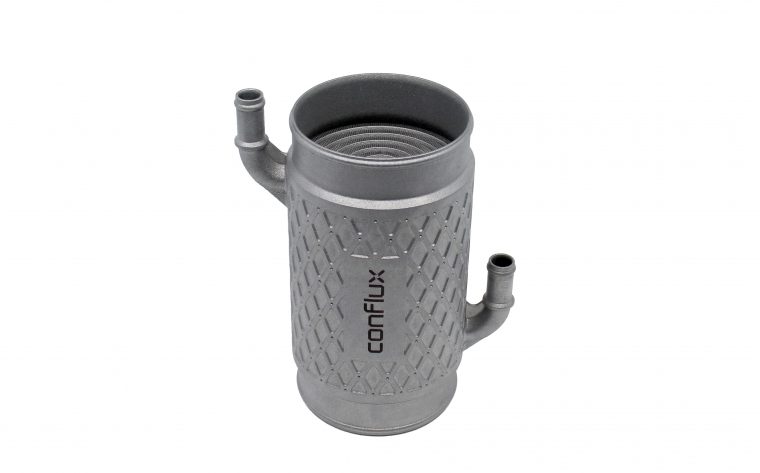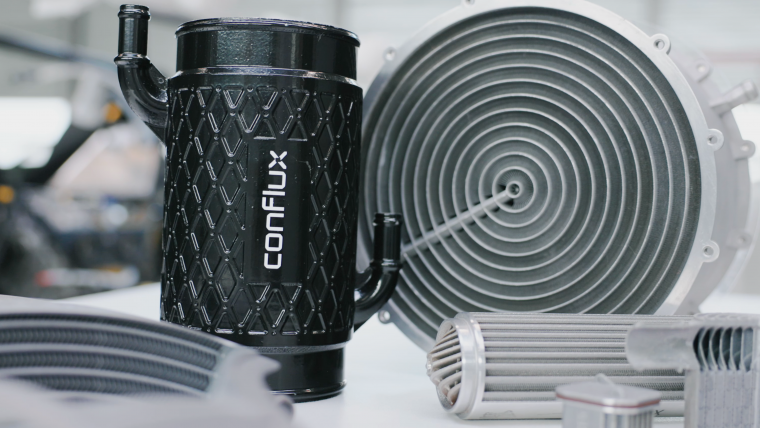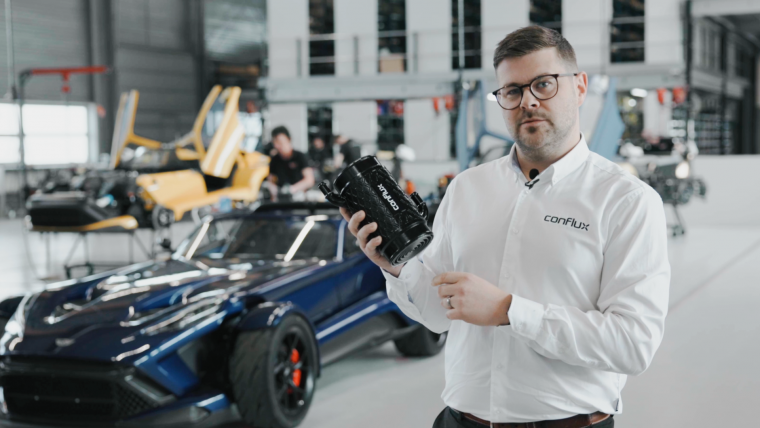- 3D Print Bureau
- 6K
- Agmatix
- Airwayz
- AKA Foods
- AM-Flow
- Appadda
- Caracol
- Carbon
- CG Trader
- Conflux
- CyberOptics
- e-Xstream
- Flamerite
- GenCell
- GreenEye
- Impossible Objects
- Incus Media
- Ineco
- InkBit
- ITG
- JPB Systeme
- KeyProd
- Landa
- LEO Lane
- Lumet
- Magic Software
- MakerBot
- Marketiger
- Nano Dimension
- Paragon Rapid Technologies
- PearlX
- Plant & Bean
- Redefine Meat
- Replique
- Ripples
- Sakuu Corporation
- Segen
- SolarEdge
- StoreDot
- Sunrock
- The Bespoke Group
- Trigo
- UltiMaker
- Xjet
Conflux and Donkervoort Bring F1-Grade Thermal Performance to the Road with the P24 RS
Lelystad, the Netherlands– 8 May 2025 – Donkervoort and Conflux have partnered to deliver a cutting-edge thermal breakthrough for the upcoming P24 RS supercar, confirming its collaboration with thermal pioneers Conflux on a new generation of 3D-printed, ultra-lightweight water-charge air coolers.
The second Engineering Chapter in the P24 RS: Living the Drive series reveals how Donkervoort and Conflux have redefined the air cooler— delivering a system that is lighter, smaller, and more efficient than anything previously seen in production cars.
The result: a pair of aluminium-alloy sculptures weighing just 1.4 kg each, compared to 16 kg for conventional air-to-air units with similar thermal capacity. These custom water-charge air coolers (WCAC) provide sharper throttle response, improved packaging, and reduced weight.
“The key to engine performance is keeping the intake air as cold as possible,” said Managing Director Denis Donkervoort. “We challenged ourselves to find the best way to achieve that—and Conflux delivered.”
“We moved to a liquid-to-air cooler, made using additive manufacturing, from a company that isn’t just on the cutting edge—they’re ahead of it. We gave Conflux our exact specifications, and they delivered a solution so effective, we could even downsize it from the original prototype.”
Thanks to their compact form, the air coolers now sit within the engine bay rather than at the front of the car—reducing the inlet-tract length of the outgoing engine by two-thirds. The result: quicker response, greater efficiency, and optimised weight distribution.
These Conflux units—designed and built in Australia—join Van der Lee’s billet turbochargers as part of Donkervoort’s high-tech evolution of the PTC engine.
Water is cooled through a bespoke external radiator, then redirected to chill the intake air before it enters the combustion chamber. That precision enables consistent, high-performance delivery—under any condition.
“Our Formula 1 technology is available beyond the track for the first time,” said Conflux Founder Michael Fuller. “We’re scaling it for the high-performance automotive market. For limited-production vehicles like the P24 RS, F1-grade solutions are finally within reach.”
Donkervoort was among the first to adopt Conflux’s production-ready air coolers, utilising cylindrical designs placed directly between the turbochargers and throttle bodies of the PTC engine. Each component is 3D-printed with tailored fin geometry, density, and size, grounded in engineering-first principles.
“Donkervoort approached us with clear cost and performance targets,” Fuller added. “Their clarity and drive made this one of our most exciting collaborations. Within our configurable product line, we could fine-tune everything—from diameter and fin density to overall length—for the most efficient design possible.”
The system also integrates a custom-sized, thin-wall radiator that provides more cooling with less coolant and a smaller surface area than its predecessor.
Together, Donkervoort and Conflux didn’t just rethink cooling. They re-engineered how performance breathes.
-
 Conflux’ custom water-charge air coolers (WCAC) provide sharper throttle response, improved packaging, and reduced weight.
Conflux’ custom water-charge air coolers (WCAC) provide sharper throttle response, improved packaging, and reduced weight.
Click here to download 300dpi images -
 The Donkervoort P24 RS air coolers now sit within the engine bay—reducing the inlet-tract length of the outgoing engine by two-thirds.
The Donkervoort P24 RS air coolers now sit within the engine bay—reducing the inlet-tract length of the outgoing engine by two-thirds.
Click here to download 300dpi images -
 Daniel France, Conflux Business Development Lead
Daniel France, Conflux Business Development Lead
Click here to download 300dpi images
Conflux et Donkervoort transfèrent les performances thermiques de Formule 1 de la piste à la route avec la P24 RS
Lelystad, Pays-Bas – 8 mai 2025 – Donkervoort et Conflux ont fait équipe pour intégrer une innovation thermique de pointe dans la prochaine supercar P24 RS, confirmant la collaboration du constructeur automobile avec Conflux, le pionnier de l’industrie des échangeurs de chaleur, sur une nouvelle génération de refroidisseurs d’air à l’eau ultra-légers imprimés en 3D.
Le deuxième chapitre d’ingénierie de la P24 RS : La série Living the Drive révèle comment Donkervoort et Conflux ont redéfini le refroidisseur d’air en créant un système plus léger, plus compact et plus efficace que jamais dans les voitures de production.
Le résultat : deux sculptures en alliage d’aluminium pesant seulement 1,4 kg chacune, contre 16 kg pour les unités air-air traditionnelles de capacité thermique similaire. Ces refroidisseurs d’air à l’eau (WCAC) sur mesure offrent une réponse plus rapide de l’accélérateur, un conditionnement amélioré et un poids réduit.
« La clé de la performance d’un moteur est de maintenir l’air entrant aussi froid que possible, a expliqué Denis Donkervoort, Directeur Général. Nous nous sommes mis au défi de trouver le meilleur moyen d’y parvenir, et Conflux a réussi. »
« Nous sommes passés à un refroidisseur liquide-air produit avec un procédé de fabrication additive par une entreprise qui, non contente d’être à la pointe, est déterminée à repousser les limites. Nous avons donné à Conflux nos spécifications exactes, et ils nous ont fourni une solution si efficace que nous avons même pu en réduire les dimensions par rapport au prototype d’origine. »
Grâce à leur forme compacte, les refroidisseurs d’air se trouvent désormais à l’intérieur du compartiment moteur plutôt qu’à l’avant de la voiture, ce qui réduit de deux tiers la longueur du circuit d’admission par rapport au moteur précédent. Le résultat : une réponse plus rapide, une plus grande efficacité et une répartition du poids optimisée.
Avec les turbocompresseurs Billet de Van der Lee, ces unités Conflux conçues et construites en Australie sont les fers de lance de l’évolution high-tech du moteur PTC de Donkervoort.
L’eau est refroidie par un radiateur externe sur mesure, puis redirigée pour refroidir l’air entrant avant qu’il ne pénètre dans la chambre de combustion. Cette grande précision permet une admission d’air régulière et performante, dans toutes les conditions.
« C’est la première fois que notre technologie de Formule 1 est transférée de la piste à la route, a déclaré Michael Fuller, fondateur de Conflux. Nous sommes en train de l’adapter au marché de l’automobile haute performance. Pour les véhicules en série limitée comme la P24 RS, les solutions mises au point pour la F1 sont enfin à portée de main. »
Donkervoort a été parmi les premiers à adopter les refroidisseurs d’air prêts à la production de Conflux, utilisant des unités cylindriques placées directement entre les turbocompresseurs et les corps de papillon du moteur PTC. Chaque composant est imprimé en 3D avec une géométrie, une densité et des dimensions sur mesure, en respect des principes d’ingénierie « engineering-first ».
« Donkervoort nous a approchés avec des objectifs de coût et de performance clairs, a ajouté Michael Fuller. Leur clarté et leur dynamisme en ont fait l’une de nos collaborations les plus passionnantes. Au sein de notre gamme de produits configurables, nous pouvions tout affiner, du diamètre et de la densité des ailettes à la longueur totale, pour parvenir au design le plus efficace. »
Le circuit intègre également un radiateur à paroi mince aux dimensions sur mesure qui offre plus de refroidissement avec moins de liquide et une surface plus réduite que son prédécesseur.
Ensemble, Donkervoort et Conflux ne se sont pas contentés de repenser le refroidissement. Ils ont repensé la façon dont la performance respire.
-
 Les refroidisseurs d'air à charge d'eau (WCAC) personnalisés de Conflux permettent une meilleure réponse de l'accélérateur, une amélioration de l'emballage et une réduction du poids.
Les refroidisseurs d'air à charge d'eau (WCAC) personnalisés de Conflux permettent une meilleure réponse de l'accélérateur, une amélioration de l'emballage et une réduction du poids.
Click here to download 300dpi images -
 Les refroidisseurs d'air Donkervoort P24 RS se trouvent désormais dans le compartiment moteur, ce qui réduit de deux tiers la longueur de l'entrée d'air du moteur sortant.
Les refroidisseurs d'air Donkervoort P24 RS se trouvent désormais dans le compartiment moteur, ce qui réduit de deux tiers la longueur de l'entrée d'air du moteur sortant.
Click here to download 300dpi images -
 Daniel France, responsable du développement commercial de Conflux
Daniel France, responsable du développement commercial de Conflux
Click here to download 300dpi images
Conflux und Donkervoort bringen mit P24 RS thermische Performance auf F1-Niveau auf die Straßen
Lelystad, Niederlande – 8. Mai 2025 – Donkervoort und der Thermik-Pionier Conflux haben gemeinsam eine bahnbrechende thermische Innovation für den neuen Supersportwagen P24 RS angekündigt. Die beiden Unternehmen bestätigen damit ihre Zusammenarbeit bei der Entwicklung einer neuen Generation von ultraleichten, 3D-gedruckten Wasser-Ladeluftkühlern.
Das zweite Kapitel in der Entwicklung des P24 RS: Die Serie „Living the Drive“ zeigt, wie Donkervoort und Conflux den Luftkühler neu definiert haben – mit einem System, das leichter, kleiner und effizienter ist als alles, was es bisher bei Serienfahrzeugen gab.
Das Ergebnis: zwei Strukturen aus einer Aluminiumlegierung mit einem Gewicht von nur 1,4 kg – herkömmliche Luft-Luft-Ladeluftkühler mit einer ähnlichen Kapazität wiegen 16 kg. Diese speziell entwickelten wassergekühlten Ladeluftkühler (WCAC) sorgen für ein besseres Ansprechverhalten und weisen neben einem geringeren Gewicht ein optimiertes Design auf.
„Die Motorleistung hängt in hohem Maße von der optimalen Kühlung der Ansaugluft ab“, sagt Geschäftsführer Denis Donkervoort. „Wir wollten die beste Lösung finden, um dies zu erreichen – mit Conflux ist uns das gelungen.“
„Wir stiegen auf einen in additiver Fertigung hergestellten Flüssigkeits-Luft-Ladeluftkühler um – von einem Unternehmen, das nicht nur auf dem neuesten Stand der Technik ist, sondern sogar einen Schritt weiter geht. Auf der Grundlage unserer Spezifikationen entwickelte Conflux eine Lösung, die sich als so effektiv erwies, dass wir unseren ursprünglichen Prototyp sogar verkleinern konnten.
Dank seiner kompakten Bauweise kann der Luftkühler jetzt im Motorraum statt an der Vorderseite des Fahrzeugs untergebracht werden, wodurch die Länge des Ansaugtrakts um zwei Drittel verkürzt wird. Das Ergebnis: kürzere Reaktionszeiten, mehr Effizienz und eine optimierte Gewichtsverteilung.
Gemeinsam mit den Billet-Turboladern von Van der Lee stellen diese in Australien entwickelten und hergestellten Conflux-Einheiten einen wesentlichen Schritt in der technologischen Weiterentwicklung des PTC-Motors von Donkervoort dar.
Die Wasserkühlung erfolgt durch einen speziell entwickelten externen Kühler. Das Wasser wird dann zurückgeleitet, um die Ansaugluft zu kühlen, bevor sie in den Brennraum gelangt. Dank dieser Präzision kann eine gleichbleibend hohe Performance erzielt werden – unter allen Bedingungen.
„Unsere Formel-1-Technologie ist erstmals auch außerhalb der Rennstrecke verfügbar“, sagt Michael Fuller, Gründer von Conflux. „Wir skalieren diese Technologie nun für den High-Performance-Automobilmarkt. Endlich sind Lösungen in F1-Qualität auch für Fahrzeuge in limitierter Auflage wie den P24 RS verfügbar.
Donkervoort gehörte zu den ersten Herstellern, die sich für die produktionsreifen Luftkühler von Conflux entschieden, die in zylindrischer Bauweise direkt zwischen den Turboladern und den Drosselklappen des PTC-Motors verbaut sind. Jede Komponente wird in 3D-Druck mit einer speziell angepassten Lamellengeometrie, Dichte und Größe unter Anwendung eines Engineering-First-Ansatzes hergestellt.
„Donkervoort trat mit klaren Kosten- und Leistungszielen an uns heran“, sagt Fuller. „Dank der Klarheit und Motivation des Teams wurde dies eine unserer spannendsten Kooperationen. Mit unserer konfigurierbaren Produktlinie konnten wir alles bis ins Detail optimieren – vom Durchmesser über die Lamellendichte bis hin zur Gesamtlänge –um ein möglichst effizientes Design zu erzielen.
Außerdem verfügt das System über einen maßgeschneiderten, dünnwandigen Kühler, der mit weniger Kühlmittel und einer geringeren Oberfläche eine bessere Kühlung erzielt als sein Vorgängermodell.
Donkervoort und Conflux haben nicht nur die Kühlung neu konzipiert. Sie haben auch neu definiert, wie Performance „atmet”.
-
 Die maßgeschneiderten Wasser-Luft-Kühler (WCAC) von Conflux sorgen für eine schärfere Gasannahme, ein besseres Packaging und weniger Gewicht.
Die maßgeschneiderten Wasser-Luft-Kühler (WCAC) von Conflux sorgen für eine schärfere Gasannahme, ein besseres Packaging und weniger Gewicht.
Click here to download 300dpi images -
 Die Luftkühler des Donkervoort P24 RS sitzen jetzt im Motorraum und reduzieren die Länge des Ansaugtrakts des bisherigen Motors um zwei Drittel.
Die Luftkühler des Donkervoort P24 RS sitzen jetzt im Motorraum und reduzieren die Länge des Ansaugtrakts des bisherigen Motors um zwei Drittel.
Click here to download 300dpi images -
 Daniel France, Leiter der Geschäftsentwicklung bei Conflux
Daniel France, Leiter der Geschäftsentwicklung bei Conflux
Click here to download 300dpi images
Conflux e Donkervoort portano le prestazioni termiche da F1 su strada con la P24 RS.
Lelystad (Paesi Bassi) – 8 maggio 2025 – Donkervoort e Conflux hanno unito le loro forze per incorporare un’innovazione termica all’avanguardia nell’imminente supercar P24 RS, confermando la partnership con i pionieri di tecnologia termica Conflux per una nuova generazione di raffreddatori d’aria a carica d’acqua ultraleggeri e stampati in 3D.
La seconda serie “Engineering Chapter in the P24 RS: Living the Drive” rivela il processo attuato da Donkervoort e Conflux per ridefinire il raffreddamento ad aria, dando vita a un sistema più leggero, più piccolo e più efficiente, una novità assoluta per le vetture di serie.
Il risultato: una coppia di sculture in lega d’alluminio che pesano appena 1,4 kg ciascuno rispetto alle unità aria/aria tradizionali da 16 kg con capacità termiche simili. Questi dispositivi di raffreddamento dell’aria a carica d’acqua (WCAC) costruiti su misura forniscono una risposta dell’acceleratore più immediata, un imballaggio migliore e un peso ridotto.
“Per garantire prestazioni ottimali del motore, la chiave sta nel mantenere l’aria aspirata il più fredda possibile” ha dichiarato l’Amministratore Delegato Denis Donkervoort. “Ci siamo lanciati nella sfida di trovare il modo migliore per riuscire in tale intento… e Conflux ha fatto centro.”
“Siamo passati a un raffreddatore liquido/aria (realizzato utilizzando la produzione additiva) di una società che non è semplicemente all’avanguardia, ma che si mantiene un passo avanti. Abbiamo fornito le nostre specifiche esatte a Conflux, che ha dato vita a una soluzione così efficace da consentirci di ridimensionare persino il prototipo originale.”
Grazie alla sua forma compatta, i raffreddatori d’aria sono posizionati ora all’interno del vano motore piuttosto che sulla parte anteriore della vettura, riducendo la lunghezza del tratto di aspirazione del motore precedente di due terzi. Ne consegue una risposta più rapida, maggiore efficienza e una distribuzione del peso ottimizzata.
Queste unità Conflux, progettate e costruite in Australia, si affiancano ai turbocompressori a billetta di Van der Lee per imporsi protagonisti dell’evoluzione high-tech del motore PTC di Donkervoort.
L’acqua viene raffreddata attraverso un radiatore esterno ad hoc e va, quindi, a raffreddare l’aria di aspirazione prima di entrare nella camera di combustione. Questa precisione favorisce prestazioni elevate e costanti in qualsiasi condizione.
“Per la prima volta, la nostra tecnologia di Formula 1 è disponibile ben oltre la pista” ha affermato Michael Fuller, fondatore di Conflux. “La stiamo scalando per il mercato automobilistico ad alte prestazioni. Per veicoli a produzione limitata come la P24 RS, le soluzioni impiegate nella Formula 1 sono finalmente a portata di mano.”
Donkervoort è stata tra le prime ad adottare i raffreddatori d’aria pronti per la produzione di Conflux, utilizzando design cilindrici posizionati direttamente tra i turbocompressori e il corpo farfallato del motore PTC. Ciascun componente è stampato in 3D con geometria, densità e dimensioni delle alette su misura, basate su principi ingegneristici fondamentali.
“Donkervoort ci ha contattati delineando costi e obiettivi prestazionali ben precisi” ha aggiunto Fuller. “La loro precisione e determinazione hanno reso questa partnership una delle collaborazioni più interessanti. A partire dalla nostra linea di prodotti configurabile, potevamo effettuare svariati perfezionamenti, dal diametro e dalla densità delle alette alla lunghezza complessiva, per dar vita al design più efficiente possibile.”
Il sistema racchiude anche un radiatore a parete sottile su misura che offre un raffreddamento potenziato con una quantità minore di refrigerante e una superficie più piccola rispetto al suo predecessore.
Insieme, Donkervoort e Conflux non si sono soffermati a rivoluzionare il raffreddamento, ma hanno anche riprogettato come ottenere prestazioni ottimali.
-
 I raffreddatori d'aria ad acqua (WCAC) personalizzati di Conflux garantiscono una risposta più precisa dell'acceleratore, un migliore imballaggio e un peso ridotto.
I raffreddatori d'aria ad acqua (WCAC) personalizzati di Conflux garantiscono una risposta più precisa dell'acceleratore, un migliore imballaggio e un peso ridotto.
Click here to download 300dpi images -
 I raffreddatori d'aria Donkervoort P24 RS si trovano ora all'interno del vano motore, riducendo di due terzi la lunghezza del condotto di aspirazione del motore uscente.
I raffreddatori d'aria Donkervoort P24 RS si trovano ora all'interno del vano motore, riducendo di due terzi la lunghezza del condotto di aspirazione del motore uscente.
Click here to download 300dpi images -
 Daniel France, responsabile dello sviluppo commerciale di Conflux
Daniel France, responsabile dello sviluppo commerciale di Conflux
Click here to download 300dpi images
Conflux y Donkervoort trasladan la tecnología de rendimiento térmico de la F1 a la carretera con el innovador P24 RS
Lelystad, Países Bajos 8 de mayo de 2025 – Donkervoort y Conflux anuncian una alianza estratégica para llevar tecnología térmica de última generación al nuevo superdeportivo P24 RS. Esta colaboración con Conflux marca el inicio de una nueva generación de interenfriadores con un sistema de refrigeración líquida impresos en 3D y ultraligeros.
El segundo capítulo en la ingeniería del P24 RS: La serie Living the Drive revela cómo Donkervoort y Conflux han reinventado el concepto de refrigerador de aire, presentando un sistema más ligero, compacto y eficiente que cualquier otro utilizado hasta ahora en vehículos de serie.
¿El resultado? Dos verdaderas esculturas de ingeniería en aleación de aluminio, con un peso de apenas 1,4 kg cada una, en contraste con los 16 kg de los refrigeradores aire tradicionales con una capacidad térmica similar. Estos interenfriadores con sistema de refrigeración líquida (custom water-charge air coolers, WCAC, por sus siglas en inglés) ofrecen una respuesta más precisa del acelerador, un mejor aprovechamiento del espacio y una notable reducción de peso.
«La clave para maximizar el rendimiento del motor es mantener el aire que entra lo más frío posible», afirma Denis Donkervoort, Director General de la marca. «Nos propusimos el reto de encontrar la forma más eficaz de lograrlo, y Conflux superó todas las expectativas», añade Donkervoort.
«Elegimos un interenfriador con sistema de refrigeración líquida producido mediante fabricación aditiva por una empresa que no solo lidera el sector, sino que marca el camino a seguir. Les dimos a Conflux nuestras especificaciones exactas y nos devolvieron un producto tan eficiente que incluso pudimos reducir su tamaño en comparación con el prototipo original», concluye Donkervoort.
Gracias a su diseño compacto, los nuevos refrigeradores de aire pueden ubicarse directamente en el compartimento del motor en lugar de en la parte frontal del vehículo, lo que permite reducir en dos tercios la longitud del conducto de admisión del motor anterior. El resultado: una respuesta del motor más rápida, mayor eficiencia general y una distribución del peso optimizada para un rendimiento superior.
Estas unidades de Conflux, diseñadas y fabricadas en Australia, se integran a los turbocompresores de palanquilla de Van der Lee, formando parte de la avanzada evolución tecnológica del motor PTC de Donkervoort.
El agua se enfría mediante un radiador externo a medida, y luego se redirige para enfriar el aire que entra antes de que este ingrese a la cámara de combustión. Esta precisión garantiza un suministro constante y de alto rendimiento, sin importar las condiciones.
«Nuestra tecnología propia de Fórmula 1 está disponible por primera vez fuera del circuito», afirmó Michael Fuller, fundador de Conflux. «Estamos llevando esta tecnología al siguiente nivel para el mercado automovilístico de alto rendimiento. Para vehículos de producción limitada como el P24 RS, las soluciones de F1 están finalmente al alcance de la mano».
Donkervoort fue uno de los primeros en incorporar los refrigeradores de aire para la producción de Conflux, utilizando diseños cilíndricos colocados directamente entre los turbocompresores y los cuerpos de mariposa del motor PTC. Cada componente se imprime en 3D con geometría, densidad y tamaño de aleta personalizados, basándose en avanzados principios de ingeniería.
«Donkervoort nos propuso unos objetivos muy claros en cuanto a costes y rendimiento», añadió Fuller. «Su claridad y determinación han convertido esta en una de nuestras colaboraciones más emocionantes. Dentro de nuestra línea de productos configurables, pudimos ajustar todo, desde el diámetro y la densidad de las aletas hasta la longitud total, para lograr el diseño más eficiente posible».
El sistema también incorpora un radiador de pared fina y tamaño personalizado, que ofrece mayor capacidad de refrigeración con menos refrigerante y una superficie reducida en comparación con su predecesor.
Juntos, Donkervoort y Conflux no solo transformaron la refrigeración, sino que dieron una nueva vida a la forma en que el rendimiento respira.
-
 Los refrigeradores de aire de carga de agua (WCAC) personalizados de Conflux proporcionan una respuesta más nítida del acelerador, un mejor empaquetado y un peso reducido.
Los refrigeradores de aire de carga de agua (WCAC) personalizados de Conflux proporcionan una respuesta más nítida del acelerador, un mejor empaquetado y un peso reducido.
Click here to download 300dpi images -
 Los refrigeradores de aire Donkervoort P24 RS se encuentran ahora en el vano motor, lo que reduce en dos tercios la longitud del conducto de admisión del motor saliente.
Los refrigeradores de aire Donkervoort P24 RS se encuentran ahora en el vano motor, lo que reduce en dos tercios la longitud del conducto de admisión del motor saliente.
Click here to download 300dpi images -
 Daniel France, Jefe de Desarrollo Comercial de Conflux
Daniel France, Jefe de Desarrollo Comercial de Conflux
Click here to download 300dpi images



